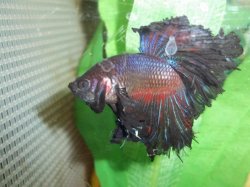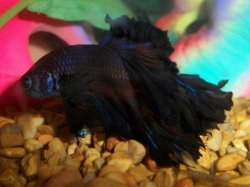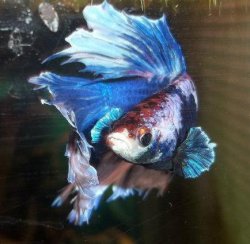I did this with my betta fish years ago. Probably 25 years ago. It was a long finned red betta. I trimmed the finns to create a straight edge as opposed to the jagged splintered fins my fish had. My fish was having issues swimming. The trimming went fine. I really removed very little fin. The interesting thing was the fin did grow back but grew back clear with no color. So the fish had long red fin with white tips. My fish never missed a beat and appeared to be much happier after the trimming.
You are using an out of date browser. It may not display this or other websites correctly.
You should upgrade or use an alternative browser.
You should upgrade or use an alternative browser.
Trimming Betta's Tail.
- Thread starter l_l_l
- Start date
I had to do this recently with a Double Tail male I have. He has been a tail biter despite everything I've tried with him, since I purchased him. A few months ago, he shredded his tail (hence his name Shredder). Despite warm pristine water, Indian Almond leaves and TLC, his fins became infected. Within less than 72 hours, the fins he had shredded himself were almost completely gone due to some organism. He was treated for bacterial and fungal infection to no avail. Finally, I had a couple of breeders recommend trying a fin trim. It had saved a few of their long finned boys lives.
The trim was a success, and upon removing the dead infected portion of fin, he healed up very well. He since has resumed tail biting, but nowhere near like he was before. It also has not become infected again. For Shredder, this was a life or death trim. Had I not done so, he would have died. The infection would not clear.
I can try to find some before and after pictures if the OP would like. I certainly wouldn't advocate a trim for cosmetic reasons, but it definitely has a time and a place. I can't remember the exact amount, but you can remove up to 1/3rd (if I recall correctly) of their fins before it can cause permanent damage. Don't quote me on this however, as I can't remember fully. I'd have to ask the breeder again.
The trim was a success, and upon removing the dead infected portion of fin, he healed up very well. He since has resumed tail biting, but nowhere near like he was before. It also has not become infected again. For Shredder, this was a life or death trim. Had I not done so, he would have died. The infection would not clear.
I can try to find some before and after pictures if the OP would like. I certainly wouldn't advocate a trim for cosmetic reasons, but it definitely has a time and a place. I can't remember the exact amount, but you can remove up to 1/3rd (if I recall correctly) of their fins before it can cause permanent damage. Don't quote me on this however, as I can't remember fully. I'd have to ask the breeder again.
He's resumed tail biting since, but he's now in a 10 gal tank with some plants and snails and his tail is growing out some, just a bit lopsided lol. But he's alive and healthy, so that's all that matters.
I used a scalpel and had him on a tiny layer of water on a plate.
Still looking for a more recent pic of him. I don't have a light for his current tank (bulbs are burnt out) or I'd get another lol. You'll just have to take my word for it that he's looking much better.

I used a scalpel and had him on a tiny layer of water on a plate.
Still looking for a more recent pic of him. I don't have a light for his current tank (bulbs are burnt out) or I'd get another lol. You'll just have to take my word for it that he's looking much better.
I shall chime in on this as well. For some bettas, the fins can become so heavy it impairs the fishes swimming ability. I will search through but I have a video of a blue halfmoon who, when not actively moving the weight of his caudal would pull him down and cause him to go vertical. I did trim his fin to help him swim better. But as for trimming to make it look pretty, there is no real reason.
I see no issue with trimming a betta's (or most other fish) if it is for a health reason. Sometimes the only way to get ahead of a bad bacterial infection is to cut away the infected fin to give it a chance to heal. Bettas in particular can have issues with their fins getting so large that they can not wrap a female when breeding or can have difficulty swimming. All 3 of these issues (to me) are reasons that a fin can be trimmed. Trimming for cosmetic reasons is both unnecessary and needlessly stressful on the fish. Trimming a fish that will be shown to get the perfect look is just downright cheating.
The benefit when trimming for the right reasons can outweigh the stress on the fish while the procedure is being done. Some situations can be life or death if the infection is bad enough. I have had to do procedures like this and never had an issue from it. As long as the fins are not cut too close to the body, there are no blood vessels and no nerve endings, it is like clipping nails (yourself or other animal).

This boy is one I had that is called an extreme rosetail. His fins were so branched and frilly that he could hardly swim most of the time. He stayed near the bottom or resting on a plant higher in the tank except on the occasions he decided to move. As seen in the picture above, even in full flare his dorsal fin and caudal fin are not able to fully extend.

In this next picture it shows him more at rest like he was normally on the substrate. Notice the dorsal fin hanging over the side of his body and his caudal all bunched up.

Another view of him in a normal state. Since he is up off the substrate this picture shows how his body seems to tilt down from the weight of his fins.
If I had known about trimming fins when I had this male, I would have trimmed his fins. He would have really benefited from the trim and ability to swim normally. As it was he passed earlier on than he probably "should" have and as he got older battled rough cases of fin melt/rot which he could not fight off like he could when younger.
OP -- In all reality, trimming does not ensure that the fin will grow back like it was supposed to. Bettas that have had fin damage can have the new fin grow back in quite funky and repeat offenders(tailbiters) -- there really is no way to tell how theirs will turn out. So I don't think that unless your boy has an issue with the way his tail is, that trimming it would do you much good.
And just because I ran across this picture which clearly demonstrates how easily a betta can get to the end of his tail if he wanted to.

Note: this male was never a tailbiter, although his fins look like he was. His fins naturally had that weird uneven look from having a bit of rosetail gene in him.
The benefit when trimming for the right reasons can outweigh the stress on the fish while the procedure is being done. Some situations can be life or death if the infection is bad enough. I have had to do procedures like this and never had an issue from it. As long as the fins are not cut too close to the body, there are no blood vessels and no nerve endings, it is like clipping nails (yourself or other animal).

This boy is one I had that is called an extreme rosetail. His fins were so branched and frilly that he could hardly swim most of the time. He stayed near the bottom or resting on a plant higher in the tank except on the occasions he decided to move. As seen in the picture above, even in full flare his dorsal fin and caudal fin are not able to fully extend.

In this next picture it shows him more at rest like he was normally on the substrate. Notice the dorsal fin hanging over the side of his body and his caudal all bunched up.

Another view of him in a normal state. Since he is up off the substrate this picture shows how his body seems to tilt down from the weight of his fins.
If I had known about trimming fins when I had this male, I would have trimmed his fins. He would have really benefited from the trim and ability to swim normally. As it was he passed earlier on than he probably "should" have and as he got older battled rough cases of fin melt/rot which he could not fight off like he could when younger.
OP -- In all reality, trimming does not ensure that the fin will grow back like it was supposed to. Bettas that have had fin damage can have the new fin grow back in quite funky and repeat offenders(tailbiters) -- there really is no way to tell how theirs will turn out. So I don't think that unless your boy has an issue with the way his tail is, that trimming it would do you much good.
And just because I ran across this picture which clearly demonstrates how easily a betta can get to the end of his tail if he wanted to.

Note: this male was never a tailbiter, although his fins look like he was. His fins naturally had that weird uneven look from having a bit of rosetail gene in him.

Ha ha! I knew I had a picture that actually showed his fins more spread out. This was as far as he was ever able to get his fins completely spread out and this was extremely rare to see.

And a picture of the above male's brother showing the same characteristics of severe rosetailing with the bunched up frilly fins that eventually led to him not being able to swim normally.
Excellent posts WildBetta, extremely informative and learning a lot here.
Can I ask, these Bettas that most of the keepers have in this hobby have been bred to have larger fins, tails and colours.
So basically, this means because of this selective breeding in which to bring out colours and larger fins and tails in Bettas, this trimming fins/tails for their health can be seen as a unseen side effect?
(much like breeding dogs, like pugs and bulldogs for example, an effect of this selective breeding meant more difficulty in breathing for these dogs due to flat areas of face / nose)
And am assuming that true wild bettas in their natural habitats do not have have these issues?
Turned out to be a real interesting thread

Can I ask, these Bettas that most of the keepers have in this hobby have been bred to have larger fins, tails and colours.
So basically, this means because of this selective breeding in which to bring out colours and larger fins and tails in Bettas, this trimming fins/tails for their health can be seen as a unseen side effect?
(much like breeding dogs, like pugs and bulldogs for example, an effect of this selective breeding meant more difficulty in breathing for these dogs due to flat areas of face / nose)
And am assuming that true wild bettas in their natural habitats do not have have these issues?
Turned out to be a real interesting thread
Thank you again for all of your input.
WildBetta, I'm also seeing my Betta struggling swimming and going full flare, he's almost never straight and like you said he mostly hangs at the bottom of the tank in my crypts. Maybe this is why his fins are showing rot or something.. From them always being in the substrate? Maybe he got an infection when they started to grow back?
His tank is in very good condition, water is being changed once every two weeks, Ammonia Nitrites and Nitrates are all at 0..
I remember when he had smaller/normal fins he was way more active / at the top of the tank..
This is my first Betta fish but I've had him for over a year now and I love him a lot.. Poor little guy has been through a lot, won his battle against velvet and got harrassed by Neon Tetras. If I knew about all of these problems with long flowing fins, I would had got a Plakat instead. Still, I'm happy I got him, he's got a good personality.
WildBetta, I'm also seeing my Betta struggling swimming and going full flare, he's almost never straight and like you said he mostly hangs at the bottom of the tank in my crypts. Maybe this is why his fins are showing rot or something.. From them always being in the substrate? Maybe he got an infection when they started to grow back?
His tank is in very good condition, water is being changed once every two weeks, Ammonia Nitrites and Nitrates are all at 0..
I remember when he had smaller/normal fins he was way more active / at the top of the tank..
This is my first Betta fish but I've had him for over a year now and I love him a lot.. Poor little guy has been through a lot, won his battle against velvet and got harrassed by Neon Tetras. If I knew about all of these problems with long flowing fins, I would had got a Plakat instead. Still, I'm happy I got him, he's got a good personality.
Yes, breeding them for longer fins and more flashy colors is a disservice at times.
Here is the blue male who needed a trim. He is not extreme rosetailed as Wildbettas male above but the length of the caudal was just as heavy.

Poor quality of video of him. Closer to the end you can see how he falls back and he cannot even keep up with the female.
http /vid3.photobucket.com/albums/y79/majerah1/Royalbluespawn005.mp4
/vid3.photobucket.com/albums/y79/majerah1/Royalbluespawn005.mp4
Wild bettas are more subdued in colors and while many males do have longer fins than females, they are in no way as long as halfmoon, deltas, veils ect.
Here is the blue male who needed a trim. He is not extreme rosetailed as Wildbettas male above but the length of the caudal was just as heavy.

Poor quality of video of him. Closer to the end you can see how he falls back and he cannot even keep up with the female.
http
 /vid3.photobucket.com/albums/y79/majerah1/Royalbluespawn005.mp4
/vid3.photobucket.com/albums/y79/majerah1/Royalbluespawn005.mp4Wild bettas are more subdued in colors and while many males do have longer fins than females, they are in no way as long as halfmoon, deltas, veils ect.
Mammabe
New Member
Wow! This thread is very interesting indeed - as you can see from my pic, my betta's fins are extremely long and he does struggle to swim, it seems like a lot of effort for sure. I never thought of this before but now I am thinking of it as this would benefit my guy. He is 2 yrs old and has never been a tail biter although I do have one of those also!
I would be afraid to do it though - I think using sharp scissors would be easier than a scalpel? I would definitely watch some videos and learn more about it first...
Also this is a good idea for the fin rot thing, I have one guy with what looks like a tic tac growing on his tail fin and it's eating away at it - I've tried fungal and bacteriat treatments then a different fungal treatment but nothing has worked so far... How would you do it if you decide to do it?
Thanks!
I would be afraid to do it though - I think using sharp scissors would be easier than a scalpel? I would definitely watch some videos and learn more about it first...
Also this is a good idea for the fin rot thing, I have one guy with what looks like a tic tac growing on his tail fin and it's eating away at it - I've tried fungal and bacteriat treatments then a different fungal treatment but nothing has worked so far... How would you do it if you decide to do it?
Thanks!
Similar threads
- Replies
- 10
- Views
- 1K
- Replies
- 3
- Views
- 1K
Most reactions
-
 345
345 -
 180
180 -
 168
168 -
 136
136 -
 129
129 -
 117
117 -
 112
112 -
 100
100 -
 96
96 -
 89
89 -
 85
85 -
 81
81 -
 75
75 -
A
63
-
 58
58






